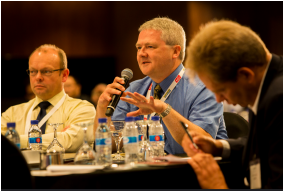|
Growing trade between Africa and Asia has prompted MTN Group, PCCW Global, Saudi Telecom Company (STC), Telecom Egypt (TE) and Telkom South Africa to sign a Memorandum of Understanding (MoU) for the construction of the new ‘Africa-1’ submarine cable system.
This consortium-funded system will connect Africa with the Middle East and South Central Asia and provide onward connectivity to Europe. Its backers hope to have it in service by the third quarter of next year. The other operators involved in the consortium to build the cable system, which will extend more than 12,000km along Africa’s east coast up to Saudi Arabia, Egypt and Pakistan (before additional branches are added), are Saudi Telecom Company, Telecom Egypt and PCCW Global. Neither MTN nor Telkom were immediately able to provide additional comment on their involvement in the cable project, including providing detail on how much they’re investing. According to a statement issued by PCCW, Africa-1 will have at least three fibre pairs at its core and will use the latest 100G wavelength technology to allow for several terabits per second of capacity to be commissioned when the system goes live. When commissioned, it will be the largest-capacity route along Africa’s east coast and will compete head-on with the other two systems connecting countries along Africa’s eastern shoreline, namely Seacom and Eassy. It will also supplement the now old and relatively low-capacity SAFE cable that connects South Africa and Asia. According to the PCCW statement, Africa-1 will offer comprehensive interconnection with other cable systems and provide full open access to service providers at cable landing stations along its route. The statement quotes MTN group executive for global carrier services and group network projects, John Unterhorst, as saying Africa-1 will “complement existing cables now nearing their mid-life”. Casper Kondo-Chihaka, managing executive of network engineering and build operations at Telkom, says in the same statement: “In addition to complementing our existing high-bandwidth cable systems in the region, Africa-1 will provide more diversity for the large volume broadband traffic from South Africa to the rest of the world. This cable will provide the means to fulfil our role as champions of national broadband access and act as catalyst to stimulate further penetration of Internet connectivity for the entire country.” The consortium hopes to sign a construction and maintenance agreement by June, with the system ready for service by September 2017. Other operators are expecting to join the five founding members of the consortium over time. Last year, South Africa’s Deputy President Cyril Ramaphosa said that trade flows between Africa and Asia had increased over the years, totalling $423bn in 2013. “As the trade links between Asia and Africa, and between the rest of the world and Africa, have continued to grow, we have responded by increasing both the capacity on our network and the services delivered across it,” PCCW spokesperson Ivan Ho told Fin24. “We have continued to invest in the continent, both in terms of submarine cable capacity and in terrestrial connectivity linking the landlocked countries in Africa to high-speed subsea capacity. Africa-1 is a natural extension of our network strategy which will help to address the increasing capacity demands of the Asia-Africa trade corridor with better levels of reliability, connecting people and businesses in some of the world’s fastest growing economies,” said the spokesperson. PCCW, over the years, has increased its presence in Africa. Having acquired regional African satellite provider, Gateway Communications in 2012, PCCW announced in 2014 that it planned to provide telecoms and technology services for the R84bn Zendai smart city project in Modderfontein, Johannesburg. Last year, PCCW also launched video-on-demand service ONTAPtv.com in South Africa. Adapted from: TechCentral, SubSeaWorldNews.com, MyBroadband.co.za ANALYSIS: Choosing to use a name for this cable which is synonymous with a failed initiative from the 1990s is an inauspicious start. Furthermore, there is a significant contrast in the quotes of, on the one hand, the PCCW spokesman and the representatives of MTN and Telkom on the other. PCCW's comments are focused on a rational macroeconomic trend between Africa and Asia whereas its partners comments are full of bluster and nonsense. With there still being no cable map available for this new system and with no further announcements about landing sites or the promised C&MA signing, one has the sense that PCCW may have jumped the gun and caught its African partners by surprise. Looking at this proposal, based on what little information has been provided so far, JRC's view is this:
0 Comments
Leave a Reply. |
Julian Rawle, AuthorThought leadership articles and commentary on developments related to the subsea fibre optic cable industry can be found here. Archives
February 2018
Categories |



 RSS Feed
RSS Feed